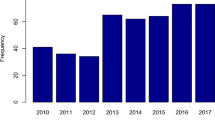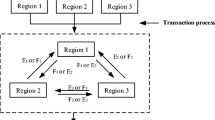Abstract
In the paper we develop a two stage scenario-based stochastic programming model for water management in the Indus Basin Irrigation System (IBIS). We present a comparison between the deterministic and scenario-based stochastic programming model. Our model takes stochastic inputs on hydrologic data i.e. inflow and rainfall. We divide the basin into three rainfall zones which overlap on 44 canal commands. Data on crop characteristics are taken on canal command levels. We then use ten-daily and monthly time intervals to analyze the policies. This system has two major reservoirs and a complex network of rivers, canal head works, canals, sub canals and distributaries. All the decisions on hydrologic aspects are governed by irrigation and agricultural development policies. Storage levels are maintained within the minimum and maximum bounds for every time interval according to a power generation policy. The objective function is to maximize the expected revenue from crops production. We discuss the flexibility of two stochastic optimization models with varying time horizon.







Similar content being viewed by others
References
Ahmad, N. (1993). Water resources of Pakistan. Lahore: Miraj uddin Press.
Anwar, A. A., & Clarke, D. (2001). Irrigation scheduling using mixed-integer linear programming. Journal of Irrigation and Drainage Engineering, 127(2), 63–69.
Azar, A. H., Murty, V. V. N., & Phien, H. N. (1992). Modeling irrigation scheduling for lowland rice with stochastic rainfall. Journal of Irrigation and Drainage Engineering, 118(1), 36–55.
Beale, M. L. (1955). On minimizing a convex function subject to linear inequalities. Journal of the Royal Statistical Society. Series B. Methodological, 17, 17–184.
Birge, J., & Louveaux, F. (1997). Introduction to stochastic programming. New York: Springer.
Bogle, M. G. V., & O’Sullivan, M. J. (1979). Stochastic optimization of a water supply system. Water Resources Research, 15(4), 778–786.
Burt, O. R., & Stauber, M. S. (1971). Economic analysis of irrigation in subhumid climate. American Journal of Agricultural Economics, 53(1), 33–46.
Butcher, W. S. (1971). Stochastic dynamic programming for optimum reservoir operation. Water Resources Bulletin (Harrisburg), 7(1), 115–123.
Dantzig, G. B. (1955). Linear programming under uncertainty. Management Science, 1, 197–206.
Dariane, A. B., & Hughes, T. C. (1991). Application of crop yield functions in reservoir operation. Water Resources Bulletin (Harrisburg), 27(4), 649–656.
Dudley, N. J. (1970). A simulation and dynamic programming approach to irrigation decision making in a variable environment. Agricultural Economics and Business Management Bulletin 9, Faculty of Agriculture Economics, University of New England, Armidale, Australia.
Dudley, N. J. (1972). Irrigation planning for optimal intraseasonal water allocation. Water Resources Research, 8(3), 586–594.
Dudley, N. J. (1988). A single decision-maker approach to irrigation reservoir and farm management decision making. Water Resources Research, 24(5), 633–640.
Dudley, N. J., & Burt, O. R. (1973). Stochastic reservoir management and system design for irrigation. Water Resources Research, 9(3), 507–522.
Dudley, N. J., & Scott, B. W. (1993). Integrating irrigation water demand, supply and delivery management in a stochastic environment. Water Resources Research, 29(9), 3093–3101.
Dudley, N. J., Howell, D. T., & Musgrave, W. F. (1971). Optimal intraseasonal irrigation water allocation. Water Resources Research, 7(4), 770–778.
Dudley, N. J., Reklis, D., & Burt, O. R. (1976). Reliability, trade-offs and water resource development modeling with multiple crops. Water Resources Research, 12(6), 1101–1108.
Economic survey of Pakistan (2005). Govt. of Pakistan, Ministry of Finance.
Ganji, A., Ponnambalam, K., Khalili, D., & Karamouz, M. (2006). A new stochastic optimization model for deficit irrigation. Journal of Irrigation Science, 25, 63–73.
Hall, W. A., Tauxe, G. W., & Yeh, W. W. G. (1969). An alternate procedure for the optimization of operation for planning with multiple river, multiple purpose system. Water Resources Research, 5(6), 1367–1372.
Hochreiter, R., & Pflug, G. (2007). Financial scenario generation for stochastic multi-stage decision process as a facility location problem. Annals of Operations Research, 152, 257–272.
Houghtalen, R. J., & Loftis, J. C. (1988). Irrigation water delivery system operation via aggregate state dynamic programming. Water Resources Bulletin (Harrisburg), 24(2), 427–434.
KaleemUllah, M., Zaigham, H., & Saim, M. (2001). Spatial distribution of reference and potential evaporation across the Indus Basin Irrigation System. International Water Management Institute, Lahore. Working Paper 24.
Karamouz, M., & Houck, M. H. (1982). Annual and monthly reservoir operating rules generated by deterministic optimization. Water Resources Research, 18(5), 1337–1344.
Kelman, J., Stedinger, J. R., Cooper, L. A., Hsu, E., & Yuan, S. Q. (1982). Sampling stochastic dynamic programming applied to reservoir operation. Water Resources Research, 26(3), 447–454.
Kijine, J. W., & Van der Velde, E. J., Jr. (1992). Irrigation management implications of Indus Basin climate change—case study. Lahore: IIMI. (From “World commission on Dams” documents.)
Labadie, J. W. (2004). Optimal operation of multireservoir systems: state-of-the-art review. Journal of Water Resources Planning and Management, 130, 93–111.
Mannocchi, F., & Mecarelli, P. (1994). Optimization analysis of deficit irrigation systems. Journal of Irrigation and Drainage, 120(3), 484–503.
Mawar, P. A., & Thorn, D. (1974). Improved dynamic programming procedure and their application to water resource systems. Water Resources Research, 10(2), 183–190.
Monge, G. (1781). Mémoire sur la théorie des déblais et des remblais. Histoire de L’Academie des Sciences. Paris, 29, 352–362.
Mujumdar, P. P., & Ramesh, T. S. V. (1997). Real-time reservoir operation for irrigation. Water Resources Research, 33(5), 1157–1164.
Oven-Thompson, K. I., Alercon, L., & Marks, D. H. (1982). Agricultural versus hydropower trade-offs in the operation of the High Aswan Dam. Water Resources Research, 18(6), 1605–1614.
Paudyal, G. N., & Gupta, A. D. D. (1990). Irrigation planning by multilevel optimization. Journal of Irrigation and Drainage Engineering, 116(2), 273–291.
Paul, S., Panda, S. N., & Kumar, D. N. (2000). Optimal irrigation allocation: a multilevel approach. Journal of Irrigation and Drainage Engineering, 126(3), 149–156.
Pflug, G. (2001). Scenario tree generation for multi-period financial optimization by optimal discretization. Mathematical Programming Series B, 89, 251–271.
Rachev, S. T. (1991). Probability metrics and the stability of stochastic models. New York: Wiley.
Rao, N. H., Sarma, P. B. S., & Chander, S. (1990). Optimal multicrop allocation of seasonal and intraseasonal irrigation water. Water Resources Research, 26(4), 551–559.
Rao, N. H., Sarma, P. B. S., & Chander, S. (1992). Real-time adaptive irrigation scheduling under a limited water supply. Agricultural Water Management, 20, 267–279.
Ravikumar, V., & Venugopal, K. (1998). Optimal operation of South Indian irrigation systems. Journal of Water Resources Planning and Management, 124(5), 264–271.
Roefs, T. G., & Guitron, A. (1975). Stochastic reservoir model: relative computational effort. Water Resources Research, 11(6), 801–804.
Sanford, S. C. (1969). Economics of water allocation within irrigation scheme. In The economics of irrigation development: a symposium. Study 6. Dep. of Agri. Eco. and Develop. Univ. of Reading, England
Schweig, Z., & Cole, J. A. (1968). Optimal control of linked reservoir. Water Resources Research, 4(3), 479–497.
Statistical Year Book (Series). (2005). Statistical Bureau of Pakistan.
Stedinger, J. R., Sule, B. F., & Loucks, D. P. (1984). Stochastic dynamic programming model for reservoir optimization. Water Resources Research, 20(11), 1499–1505.
Sunantara, J. D., & Ramirez, J. A. (1997). Optimal stochastic multicrop seasonal and intraseasonal irrigation control. Journal of Water Resources Planning and Management, 123(1), 39–48.
Torabi, M., & Mobasheri, F. (1973). A stochastic dynamic programming model for the optimum operation of the multi purpose reservoir. Water Resources Bulletin (Harrisburg), 9(6), 1089–1099.
Umamhesh, N. V., & Sreenivasulu, P. (1997). Two-phase stochastic dynamic programming model for optimal operation of irrigation reservoir. Water Resources Management, 11, 395–406.
Vedula, S., & Kumar, D. N. (1996). An integrated model for optimal reservoir operation for irrigation of multiple crops. Water Resources Research, 32(4), 1101–1108.
Vedula, S., & Mujumdar, P. P. (1992). Optimal reservoir operation for irrigation of multiple crops. Water Resources Research, 28(1), 1–9.
Wardlaw, R., & Barnes, J. (1999). Optimal allocation of irrigation water supplies in real time. Journal of Irrigation and Drainage Engineering, 125(6), 345–353.
Warsi, M. (1991). Indus and Other River Basin of Pakistan, stream flow records. Case Study Report. WAPDA.
Water And Power Development Authority (WAPDA) (2007). Pakistan.
World Bank (1992). Irrigation planning with environmental consideration. World Bank, Technical Paper 166, Washington, DC.
World Commission on Dams (2000). Tarbela Dam and related aspects of the Indus River Basin, Pakistan, A WCD case study research report. Asianics Agro-Dev. International (Pvt) Ltd Cape Town.
Ximing, C., McKinny, D. C., & Lasdon, L. (2003). Integrated hydrologic-agronomic-economic models for river basin management. Journal of Water Resources Planning and Management, 129(1), 4–17.
Yeh, W. W. G. (1985). Reservoir management and operation models: a state-of-the-art review. Water Resources Research, 21(12), 1797–1818.
Acknowledgements
We are greatly thankful to Dalia Bach from the University of Columbia, who helped us a lot to improve this paper. Thanks to referee for his value suggestions.
Author information
Authors and Affiliations
Corresponding author
Additional information
This research work is sponsored by Higher Education Commission (HEC), Pakistan.
Rights and permissions
About this article
Cite this article
Muhammad, Y.S., Pflug, G.C. Stochastic vs deterministic programming in water management: the value of flexibility. Ann Oper Res 223, 309–328 (2014). https://doi.org/10.1007/s10479-013-1455-8
Published:
Issue Date:
DOI: https://doi.org/10.1007/s10479-013-1455-8




